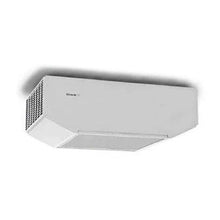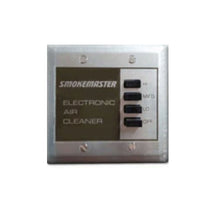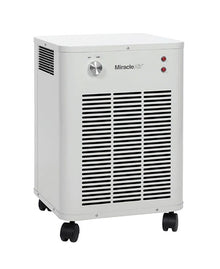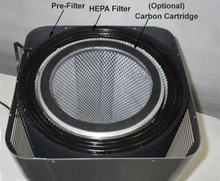The Showdown: Smokeless Ashtray vs. Air Purifier—An Expert Breakdown
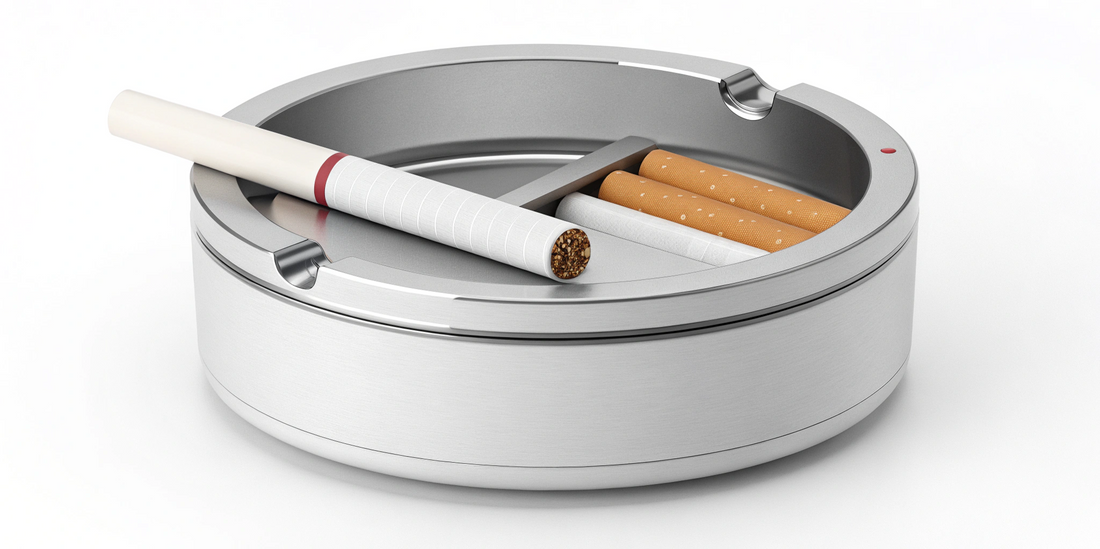
By the Experts at Commercial Air Purifiers | Published: October 18, 2025
For anyone who enjoys a cigarette or cigar indoors, the goal is often the same: to savor the experience without letting the smoke and its persistent odor take over the room. In the search for a solution, two very different devices often appear: the compact, affordable smokeless ashtray and the more substantial, powerful air purifier. On the surface, they seem to serve a similar purpose, but in reality, they are worlds apart in their technology, scope, and effectiveness. Choosing between them isn't just a matter of budget; it's a decision about your fundamental approach to air quality.
If you're wondering whether a small gadget can truly solve a whole-room problem, you've come to the right place. As air quality experts, we're here to pull back the curtain on these two technologies. This definitive guide will break down the science of how each one works, offer a head-to-head comparison of their real-world performance, and give you the knowledge you need to make an informed choice for a cleaner, healthier, and odor-free environment.
Understanding the Enemy: The Two Faces of Secondhand Smoke
Before we can compare the tools, it's critical to understand the problem we're trying to solve. Secondhand smoke is not a single, uniform cloud. It's a complex mixture that is notoriously difficult to contain, composed of two distinct types of smoke.
First, there is mainstream smoke, which is the smoke that is inhaled and then exhaled by the smoker. Second, and far more problematic, is sidestream smoke. This is the smoke that drifts directly from the burning end of a cigarette or cigar. According to the U.S. Centers for Disease Control and Prevention (CDC), sidestream smoke is chemically different from mainstream smoke and contains higher concentrations of many of the most toxic compounds, including carcinogens.
Crucially, both types of smoke are composed of hot gases and incredibly light particles. Due to simple physics, this hot smoke rises and, driven by the natural air currents in any room, disperses with astonishing speed. It does not simply float up to the ceiling; it rapidly mixes with the entire volume of air in the space. This is the fundamental challenge: you are not trying to capture a slow-moving cloud, but rather to filter thousands of microscopic particles and gaseous chemicals that have already filled the room.
The Fundamental Difference: Localized Capture vs. Whole-Room Purification
The most significant distinction between a smokeless ashtray and an air purifier lies in their core design philosophy. One is a tool of localized capture, attempting to catch smoke at its source, while the other is a system of whole-room purification, designed to continuously scrub the entire environment.
The Smokeless Ashtray: A Miniature Smoke Funnel
At its core, a smokeless ashtray is a simple gadget. It consists of a small, typically battery-operated fan housed within an ashtray casing. When a cigarette is placed on the rest, the fan is designed to pull the sidestream smoke downwards into a small chamber. This chamber is usually protected by a very basic filter—often a thin, mesh-like pad that has been lightly coated with activated carbon.
The operating principle is to capture a fraction of the sidestream smoke before it can escape. Think of it like trying to catch all the rain in a storm with a single coffee cup. While it will certainly catch the drops that fall directly into it, it will have absolutely no effect on the downpour happening everywhere else. It is a device with an effective range measured in inches, not feet.
The Air Purifier: A Room-Sized Air Scrubber
A high-quality air purifier, by contrast, is a powerful environmental control system. It is built around a robust motor and fan engineered to move a massive volume of air. Instead of trying to catch smoke at one tiny point, it works by continuously pulling in all the air from the entire room, forcing it through a sophisticated, multi-stage filtration process, and re-circulating the clean air.
This process typically involves:
-
A Pre-Filter: To capture large particles like dust and hair.
-
A True HEPA Filter: A dense, medical-grade filter designed to capture 99.97% of microscopic airborne particles, including all the solid components of smoke.
-
A Substantial Activated Carbon Filter: A deep bed of activated carbon, often weighing several pounds, designed to adsorb the gaseous VOCs, chemicals, and odors that pass right through other filters.
An air purifier is like a high-powered drain for your room's air, constantly removing pollutants to maintain a clean equilibrium.
Gauging Performance: Where the Rubber Meets the Road
Understanding how they work is one thing; understanding how they perform is what truly matters. Let's compare them across the three key challenges of tobacco smoke.
Particle Removal (The Visible Smoke)
The visible component of smoke is made of fine particulate matter (PM2.5). A smokeless ashtray will capture some of the sidestream smoke particles that are drawn directly into its weak fan. However, it does absolutely nothing to capture the particles from the far more voluminous sidestream smoke that naturally rises and disperses, nor does it capture any of the mainstream smoke exhaled by the smoker.
An air purifier equipped with a HEPA filter, as detailed by the Environmental Protection Agency (EPA), is the gold standard for particulate removal. It doesn't discriminate. Whether it's sidestream or mainstream smoke, once the particles are airborne, the purifier draws them in and traps them permanently. It is the only way to effectively remove the physical "smoke" from the air you breathe.
Gas & VOC Removal (The Invisible Odor)
This is where the difference becomes most stark. The persistent, stale smell of smoke comes from thousands of gaseous Volatile Organic Compounds (VOCs). A smokeless ashtray's tiny carbon pad contains, at most, a few grams of activated carbon. It becomes saturated—meaning it can't adsorb any more molecules—almost instantly. It has a negligible, near-zero impact on the room's overall odor level.
An air purifier designed for smoke, on the other hand, contains pounds of activated carbon, providing an immense surface area for adsorption. This deep carbon bed can continuously pull odor-causing gases and harmful VOCs out of the air for months before needing replacement. This is the single greatest factor in truly eliminating smoke smell, rather than just masking it.
Scope of Operation (The Room vs. The Tray)
This is the final, decisive comparison. A smokeless ashtray has an effective range of only a few inches around itself. It cannot clean the air you are breathing, protect your furniture from residue, or prevent the smell from spreading to the next room.
An air purifier's effectiveness is measured by its CFM (Cubic Feet per Minute) rating, which determines its ability to clean an entire room. A properly sized unit can achieve multiple Air Changes per Hour (ACH), meaning it cleans the entire volume of air in your room over and over, systematically removing pollutants from every corner.
Beyond the Science: Living with Your Choice
The practical differences in ownership are just as important as the technical ones.
Cost and Maintenance
A smokeless ashtray has a very low upfront cost, which is its main attraction. However, it often requires frequent battery changes and a constant supply of small, proprietary filter pads that provide little actual filtration value. An air purifier is a larger initial investment. Its robust filters need to be replaced periodically—a more significant expense that reflects a vastly greater capacity and a real, measurable impact on air quality.
Long-Term Value & "Thirdhand Smoke"
Perhaps the most critical long-term issue is thirdhand smoke—the sticky, toxic residue that smoke leaves behind on every surface in a room. A smokeless ashtray does virtually nothing to prevent this, as it allows the vast majority of smoke to circulate and settle. This is why a room with only a smokeless ashtray will still develop a permanent stale smoke smell. An air purifier, by constantly removing airborne particles and VOCs, dramatically reduces the amount of residue that can form on your walls, furniture, and carpets. This not only prevents the lingering odor but also reduces the long-term health risks associated with this toxic film.
Making the Right Choice for Your Air Quality Goals
Ultimately, the right choice depends on your goals.
A smokeless ashtray might be a minor aid if: your primary goal is simply to reduce the visual smoke rising from a cigarette while it's resting in the tray. It should be seen as a novelty gadget, not an air quality tool.
An air purifier is the only viable choice if: your goal is to actually clean the air. It is the only effective solution for noticeably reducing smoke, eliminating odors, protecting your health and the health of those around you, and preventing the long-term damage of thirdhand smoke. High-performance systems for smoke combine both HEPA and heavy carbon filters to address the complete problem.
For those serious about clean air, exploring a range of Home & Office Smoke Eaters is the next logical step. The power of these units is determined by their airflow, which is why Understanding CFM: The Most Important Air Purifier Metric is essential reading.
The Verdict: Gadget vs. Solution
While the idea of a small, inexpensive smokeless ashtray is appealing, it's crucial to recognize its profound limitations. It is a gadget that addresses a tiny fraction of the problem at a microscopic scale. An air purifier, in contrast, is a comprehensive solution designed to manage the entire environmental challenge of indoor smoking. It is an investment not just in a machine, but in a healthier, cleaner, and truly odor-free living space.
Ready for a real solution to indoor smoke? Explore our range of high-performance air purifiers.
Your Questions Answered: Ashtrays vs. Purifiers
Can I use a smokeless ashtray and an air purifier together?
Yes, you can. The ashtray may capture a very small percentage of smoke directly at the source, which could theoretically lessen the total load on the purifier. However, it's important to understand that the air purifier will still be responsible for over 99% of the actual air cleaning.
Are there different types of smokeless ashtrays? Do any of them work well?
Most smokeless ashtrays on the market operate on the same principle: a small fan and a small filter. While some models may have a slightly stronger fan or a marginally better filter pad, none can overcome the fundamental flaws of their limited scope and inadequate filtration capacity. They are not a substitute for a true air purification system.
What's more important for smoke: a HEPA filter or a carbon filter?
This is a common and important question. The answer is that they are both absolutely essential and serve different functions. The HEPA filter removes the solid particles (the visible "smoke" and invisible PM2.5), while the activated carbon filter removes the gaseous VOCs (the "smell" and harmful chemicals). An effective smoke-eating purifier must have a robust version of both.
How much do I need to spend on an air purifier for it to be effective against smoke?
Effectiveness is tied directly to performance specifications, not just the price tag. Instead of focusing on price, look for the key metrics: a CFM rating that is high enough to achieve at least 8-10 air changes per hour in your room, and a filter that contains several pounds of activated carbon. These two features are the best indicators of a unit's ability to handle heavy smoke.

